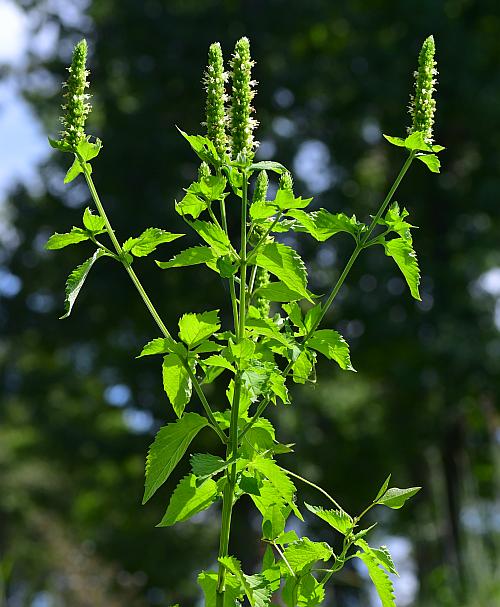Agastache nepetoides (L.) Kuntze
Yellow Giant Hyssop

Native
CC = 4
CW = 3
MOC = 57
© SRTurner
Agastache nepetoides (L.) KuntzeYellow Giant Hyssop | |
 |
Native CC = 4 CW = 3 MOC = 57 |
© SRTurner |
|
Family - Lamiaceae Habit - Perennial forb with fibrous roots, sometimes rhizomatous. Stems - Erect, to 2 m, strongly 4-angled, often with two opposite faces concave and with these alternating at each node in a decussate fashion; glabrous or with inconspicuous hairs at the nodes, hollow, branching (typically in the apical 1/2), single from the base.
Leaves - Opposite, petiolate, decussate. Petioles to 7 cm long, with an adaxial groove, mostly glabrous but sparsely pilose in the groove especially near the base of the blade. Blades ovate, to 11 cm broad, 15 cm long, crenate-serrate to serrate, rounded or subcordate at the base, acute, villous below, sparse pubescent above. Veins impressed adaxially, expressed abaxially.
Inflorescences - Terminal spikes 4-20 cm long, dense, cylindrical, 2.0-2.5 cm in diameter, the bracts elliptic-ovate to broadly ovate, shorter than to slightly longer than the calyces. Peduncle of spike densely pubescent. Flowers sessile.
Flowers - Calyces actinomorphic, to 6.5 mm, the lobes to 2.5 mm at flowering, pale green. Corollas zygomorphic, to 8 mm, pale yellow, the outer surface sparsely to moderately short-hairy, the tube narrowly funnelform, shallowly 2-lipped, the upper lip shallowly 2-lobed, the lower lip somewhat spreading, 3-lobed with a large central lobe and 2 small lateral lobes at its base. Stamens 4, strongly exserted, the lower 2 stamens with slightly shorter filaments, the upper 2 stamens with slightly longer, straight filaments. Ovary deeply lobed, the style appearing nearly basal from a deep apical notch. Style exserted, more or less equally 2-branched at the tip.
Fruits - Dry schizocarps, separating into usually 4 nutlets, these 1.2-1.5 mm long, oblong-obovoid to oblong-ellipsoid, the surface yellowish brown, densely and minutely hairy at the tip, otherwise glabrous and slightly roughened
Flowering - July - September. Habitat - Open woods, thickets, moist soils, railroads. Origin - Native to the U.S. Other info. - This species is common throughout Missouri and much of the Midwest. It is quite striking, usually having numerous inflorescences in a distinctive candelabra-like array. The sharply 4-angled stems are also a strong clue to the plant's identity. These are something like I-beams in architecture, with the opposite, concave faces alternating their orientation at each node. The corollas are usually very pale yellow, appearing almost white in some cases. The flowers within each inflorescence seem to bloom in a random order, and the plant remains in flower over a relatively long period of time. Traditionally this species was used mixed with others and used to treat poison ivy. It is easily grown, attractive to bees and butterflies, and highly deserving of more widespread cultivation. Photographs taken in the Ozark Scenic Riverways, Shannon County, MO., 7-29-03 (DETenaglia); also at Shaw Nature Reserve, Franklin County, MO, 7-29-2010, 9-29-2013, and 8-4-2021; Weldon Spring Conservation Area, St. Charles County, MO, 8-15-2010 and 8-20-2020; near Valmeyer, Monroe County, IL, 9-26-2011, and along the Katy Trail in Warren County, 9-18-2018 (SRTurner). |